Browse in the Library:
Villa-Lobos: 12 Études for Guitar – A Musical Analysis
Étude No. 1
This Étude is relatively similar in both editions. The tempo marking in the 1928 Manuscript is marked as Animé while the 1990 Edition has Allegro non troppo. There is also one dynamic marked for both versions in the beginning; the 1928 Manuscript states mezzo-fortewhile the 1990 version advises piano.
The main difference in material derives from repeat
markings. In the original 1928 Manuscript, there are no repeat markings. In the 1990 edition, there are repeat markings in every measure except 22, 23, 24, 25, 32, 33, and 34(mm. 30-31 are repeated as a two measure repeat). Also, m. 23 is a written-out repeat of m. 22.
There are varied opinions on this change. Some performers believe it sounds less like a studywithout repeats and that harmonic motion is not drawn out so long. On the other hand, the étudeis very short without these repeats.


The other material differences involve the last three measures of the piece. In the 1990Edition, the E in the third beat is labeled as a harmonic. In the 1928 Manuscript, however, this E is clearly notated as a note. Villa-Lobos takes time to interrupt the harmonic markings above the notes and fill in the sixteenth note.
Another small change in these measures is the third beat of m.33 in the 1990 Edition; the high E in the chord is a regular note while the 1928 Manuscript has a clearly-labeled harmonic E. The Manuscript copy appears better-intentioned with the uniformity of the last chord’s B harmonic.
Étude No. 2


The most peculiar difference between the two versions of this étude is the last two measures. While the dyads in the last two measures of the 1990 version are labeled as harmonics, the dyads in the 1928 manuscript are actually significantly more technically demanding. In Example 2B, it can be seen that “md” plucks the top notes while “pizz mg.” plucks the lower note in the dyads.
“Md” means main droite, or right hands, and “mg” means main gauche, or left hand. The overall action is that the left hand frets the dyads and as the right hand plucks the top notes, the left hand simultaneously hits the fret of the lower dyad.
While confusing, the ‘Carlevaro’ manuscript supports this intention as Yates confirms that the manuscript states, “Pizz.tos simultaneous da máo esquerda na mesma (pluck simultaneously with the right and left hands on the same [string])” (Yates 9)*.
Étude No. 3
The organization of the two versions of this étude differs dramatically. In the 1990 Edition, there is a ‘da Capo’ repeat at the end of measure 23. In the repeat of measures 1-23, theperformer repeats all measures twice, as indicated the first time through.
The 1928 Manuscript, however, is extremely detailed in directing what the performer repeats. In this version, Villa-Lobos does not have a ‘da Capo,’ but rather writes out a variation of the material repeated in the 1990 Version. The material after measure 23 in the 1928 Manuscript is measures 1-10 in the 1990 Version without repeats. Next, are measures 11, 12, and 13, in the 1990 Version, each
repeated once.
Measures 14, 15, 16, 17, and 18 follow without repeats. Finally, measures 19, 20, and 21, all repeated, precede measure 22 and 23 and returns to measure 24 in the 1990 Version.
The organization in the 1928 Manuscript appears to be more thoughtful and interesting than the da Capo in the 1990 Version. It would appear that Villa-Lobos thought through the more musically-interesting and climactic measures and chose to repeat those. David Leisner agrees in the more thoughtful approach of the manuscript, noting that it is, “certainly more Modernist in its desire to break the traditional rules of symmetry” (Leisner 34).


Another peculiar aspect of this étude is the ending harmonics. In Example 3A, it isapparent that Villa-Lobos intends for the performer to pluck a half note D on the fifth stringwhile playing a harmonic on the fifth string G. The 1990 Version, however, shows a D and Gharmonic on the fifth fret (Example 3B).
Looking at other manuscripts, especially the 1953 manuscript seems to confirm, however, that the intention of Villa-Lobos is what he wrote in the1928 Manuscript. David Leisner confirms this stating that the 1990 Version contains apublishing error and that “The top note is a harmonic while the bottom note is not” (Leisner 35).
There are also some minor dynamic differences between the two versions that can beviewed in the table. There are also many tempo changes that can be viewed in the table. As aresult of the very precise nature of the 1928 Manuscript, it is evident that the 1990 Versionsuffers from a lack of detail in Villa-Lobos’s reworking in 1953 and also some still-uneditedpublishing errors.
Étude No. 4
In another example of the precise nature of the 1928 Manuscript, measures 17, 18, 19, and20 in Étude No. 4 take on a very different effect in both versions. While this section in the 1990Version blends in with the constant sixteenth note texture, the 1928 Manuscript differentiatesthese two measures with added accents.

As can be seen in Example 4A, these accents create more of an added vertical texture. Because measure 17 and 18 are exactly alike (as are 19 and 20) it would appear Villa-Lobos intended to have these accents to further differentiate this point in the piece from the other sections.



The second notable divergence in the scores is in measure 62. As can be seen in Examples4B and 4C, the harmonic is the same in both beats of the1928 Manuscript, while the 1990Version has two different harmonic chords. A general observation regarding these two examples is the amount of detail in the 1928 Manuscript when compared to the 1990 Version. The 1990Version misses dynamics, fingerings, and articulation marks.
The loss of dynamics, fingerings, tempo markings, and articulations is most likely due to Villa-Lobos’s rushed time schedule around 1953 or possibly a gross overlooking by Max Eschig. It is highly recommended that the reader looks through the table at the end of this work to fill in a lot of missing details.
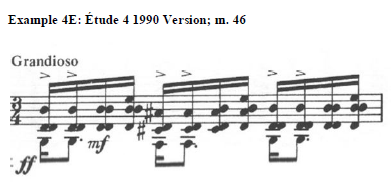
An illustrative example of oversight on the part of Max Eschig is measure 46. Villa-Lobos’s obvious intentions from the 1928 Manuscript for this “Grandioso” section is to emphasize the first two notes of each beat.
In Example 4E, however, the publisher confusingly places a ‘mf’ where it could be misconstrued to be the dynamic for the rest of the section. With this dynamic being the last of the section, the placement of the dynamic, while done with goodintentions, could cause confusion regarding the intentions of Villa-Lobos.
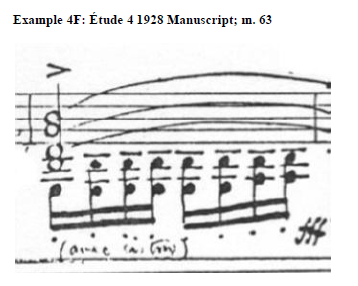
A final point to make about the difference in intentions behind both versions is exemplified in Example 4F. In this section that closes Étude No. 4, the 1990 Version shows no directive regarding right-hand fingerings.
It is very common for guitarists to play these drivingchords with the thumb. However, as seen in the 1928 Manuscript, Villa-Lobos writes, “avec I et M.” This is indicative of Villa-Lobos’s intention to have the performer play fingers ‘I’’ and ‘M,’however this suggestion is lost in the published edition.
Étude No. 5
A major problem with Étude No. 5 is the presence of many divergent notes that completely alter the harmonic nature of the surrounding material. The first notable difference between notes of the versions occurs in measure 9. The last melodic eighth note in the 1928Manuscript is an F while the 1990 Edition has a G.
When discussing this error, it is imperative to examine the melody’s character to this point. The melody is completely stepwise until this point. This characteristic would seem to support the 1928 Manuscript of having an F instead of G.
In measure 10, the ostinato suddenly changes in the second eighth note of the 1928Manuscript to an E instead of a B that is in the 1990 Edition. Yates* hypothesizes that the E could be, “substituted-perhaps to relieve the dissonance otherwise produced.”
By m. 22, achromatic ostinato has developed in the 1990 Edition; however, Villa-Lobos disrupts this ostinato by placing a Bb in the last beat. It is noted, however, that the Bb resolves up to a B natural in the downbeat of the next measure. This makes the B natural tonality written in the1990 Edition somewhat stagnant. A final change is in measures 48 and 49, where there is a second Bb half note in measure 48 (preceded by a grace note) in the 1928 Manuscript and the addition of an E-natural in the second half of the measure.
The progression of B-E-A in the bass seems to support this addition as Villa-Lobos’s intention.

The most peculiar difference in the two versions comes in measures 27 and 28. While the slur in the 1990 Edition is from D to B (Example 5A), the 1928 Manuscript (Example 5B)uses a more advanced technique that slurs from D to both B and E on the first and second string.
Unusually, in a similar passage in m. 31, both versions have slurs like the ones found in the 1990Edition in measures 27 and 28. When implemented correctly, the 1928 Manuscript’s slurs cansound interesting; however, it is very easy to distract from the bass E note that is the focus of thepassage.

Another interesting point to make regarding this étude is the use of articulation that has been discussed by David Leisner at large. In measures 17-19 seen in Example 5D, Villa-Lobos can be seen notating the melody with tenuto marks in the 1928 Manuscript.
In the 1990 Edition, however, the tenuto marks are accents instead. Leisner believes, “the tenuto of the Manuscript is a subtler marking than the more percussive accents of the Published Edition” (Leisner 36).
With this étude having a particular emphasis on melodic interaction with an ostinato, dynamics are incredibly important to highlight the harmonically-complex passages that exist above a motoric ostinato.

Because the 1990 Edition has less than five dynamic markings and minimal crescendos/decrescendos, it is helpful to analyze Villa-Lobos’s original intentions in dynamics of sections in the 1928 Manuscript. Possibly the most inventive passage is measures 48-53, seen inExample 5C. In this example, the music comes from a piano in the ‘poco meno’ section (measure 46) and crescendos up to a forte in measure 50. From here, the music continues to fit the contour of the line by a further crescendo in measure 51.
However, quite suddenly, this crescendo evolves into a piano in measure 52. In this harmonically-tense measure, it is quite an unusual intention for Villa-Lobos to want the music to suddenly subdue itself. Whether Villa-Lobos reevaluated his original dynamical intentions with this passage remains to be unknown; however, his details in the 1928 Manuscript are definitely worth noting to augment the musical character of the piece.
Étude No. 6
This étude has peculiarities in both scores.

In measure 2 of the 1928 Manuscript, the fourth chord has an F-natural (Example 6A). Meanwhile , the same passage in the 1990 Version has F# for this chord. The peculiarity of this is that Villa-Lobos writes F-natural in the 1928 Manuscript for mm. 2, 3, 29, and 30 but disregards the F# in the recap of this passage in mm. 56 and 57. This could be an oversight on
the composer’s part, but given how detailed this manuscript is, it is an anomaly and gives more credence to the 1990 Edition.
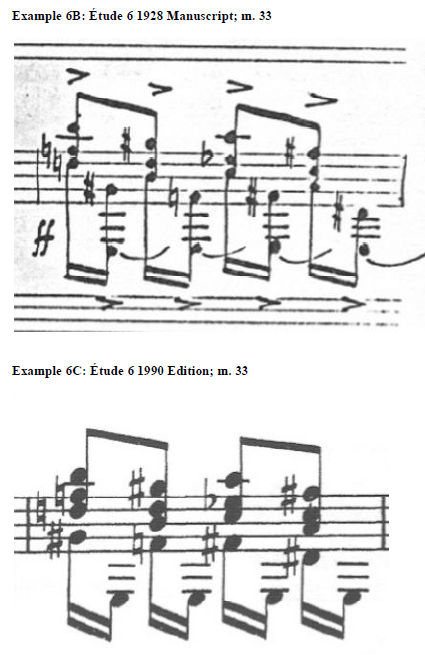
This study is very much an exercise in texture. The beginning 27 measures are repeated with a differing texture that is a mixture between 4:1 (seen in Example 6C) and 3:2 (seen in Example 6B).
The 1990 Edition solely changes texture with 4:1 while the 1928 Manuscript diverges to a 3:2 rhythm in measure 33 (Example 6B). The 1928 Manuscript then reverts to the 1990 Edition measure 42. Leisner argues that the 1990 Edition is preferable by noting that it has a “physically superior solution” (Leisner 36). This version, however, requires the thumb to jump back and forth from the 4th string to 6th string, but frees up the left hand.
On the other hand, the 1928 Manuscript requires the index finger to jump from 3rd to 4th string only but provides less time for the left hand to alternate positions. Overall, there are challenges in both physical techniques.
The tempo and dynamic markings between the two scores appear to have two differing interpretations of the music. For example, among the little markings in the 1990 Edition, there is a peculiar passage at measure 39 where the score states ‘Meno.’
This is strange because this is not at the beginning of a phrase. There is a crescendo here that appears to follow the contour of the line but is still a little out of place since the crescendo does not end at a dynamic until measure 58 (which is much too long of a crescendo given the material of the piece).
However, the 1928 Manuscript appears much more informed. All the dynamics follow contours of the
melodic line and dynamics are meticulously described in full. The tempo indicators begin in logical places, like in measure 46 (‘un peu moins (tres energique)’) and follow a progression that gradually becomes broader and slower. The 1990 Edition, meanwhile, confusingly gets faster and slower without regard to the material.
The three dynamic markings in the 1990 Edition seem to come from a completely different and uninterested composer in comparison to the meticulous details written in the 1928 Manuscript.
Please, subscribe to our Library. Thank you!
Étude No. 7
Of first note in Étude No. 7 is the harmonic discrepancy. In measures 8-11 of the 1928Manuscript, the last note of measure eight is A#, the last note of measure nine is A#, and the last note of measure ten is A-natural.
This is in contrast to the 1990 Edition, where the last notes of measures eight, nine, and ten, respectively, are: A#, A-natural, and A#. As far as moving the harmonic motion forward, the 1928 Manuscript seems much more supportive and interesting.

When measures 8-11 are repeated from measure 38-40 (Example 7A), there is a noticeable omission of about one measure. This is only the case in the 1990 Edition, and all measures 8-11 are repeated in measures 38-41 in the 1928 Manuscript. There is really no explanation for this omission. With the 1990 Edition being edited for misprints, it is strange that this omission is still confusing guitarists.
The majority of the discrepancies between the two editions come in the middle section(measures 13-30). The only directive provided by the 1990 Edition is the word ‘Moins’ inmeasure 13. Conversely, the 1928 Manuscript has the word ‘Modere’ in measure 13 followed by‘Lent’ in measure 19, ‘Modere’ again in measure 22, and then an allargando towards the end of measure 28.
Many guitarists find these rather sudden tempo changes to be jolting and drag out the section far too much. However, there is harmonic reasoning behind these tempo changes, and it is hard to say whether Villa-Lobos was well-intentioned to strip the section of any type of rubato feel in the overall scheme of the passage.
Étude No. 8

The beginning of Étude no. 8 possesses a few notable differences between the scores. Example 8A, it is displayed that there are eighth-note triplets in measures 1, 3, and 4 for the 1928Manuscript while Example 8B shows simple eighth-note quarter note pattern in the same passage for the 1990 Edition.
The particular details in the 1928 Manuscript, including the glissandos slurs and ‘mysterieux’ label, create a completely unique feel to the music that is unimaginable with the barren score of the 1990 Edition. The sole tempo marking for all the études appears in the 1990 Edition. This also encourages a little less musicality in the 1990 Edition with the restrictive tempo suggestion.
A final observation that can be made is that the melody is much more apparent in the 1928 Manuscript through the smaller note heads in the accompaniment and‘très lie et bien chanté’ directive.
Example 8A also shows the importance of dynamics. The decrescendos indicate the music is to gradually become more and more quiet. There are no indicators of dynamics in the subsequent Example 8B from the 1990 Edition. The slurs do have the natural dynamics of decay, however, it is difficult to know the over decay that the larger phrase has without these indications of decrescendos.

In measure 47 of the 1990 Edition, there is an extra G# that adds dissonance to thepassage. This is just a F# in the melody for the 1928 Manuscript. The 1990 Edition is muchmore interesting in this case because this measure repeats in the subsequent measure 49.
Étude No. 9
The content difference in Étude No. 9 for both versions deals with a repeat in the 1990Version at the end of measure 17. While some recordings, such as Alvaro Pierri, abide by this repeat, it is a little too repetitive and musically is hard to make sense out of.
The repeat goes back to the beginning; however, continuing onto the music in measure 18 and not repeating the section is more consistent with the ornamented repeat of this section in measure 30. The 1928Manuscript does not feature this repeat.
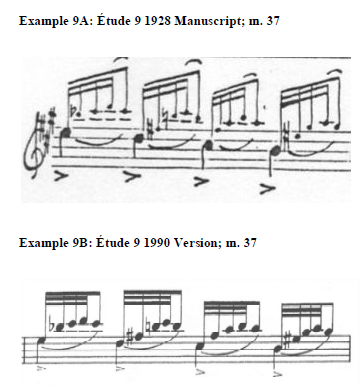
The second major difference in this study is the articulation. As can be seen in Examples9A and 9B, the interpretation of the articulation is very different for both versions. The articulation inherently shows gesture and accenting patterns. However, many performers have interpreted Example 9B to be plucked all the way through, while Example 9A clearly indicates a pull-off slur.
This point becomes even more valid in measures 42-45, when the technique can conceivably easier to pluck throughout (keeping the sound legato).
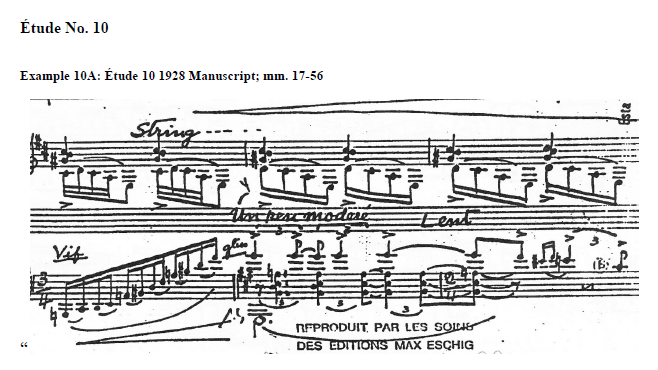
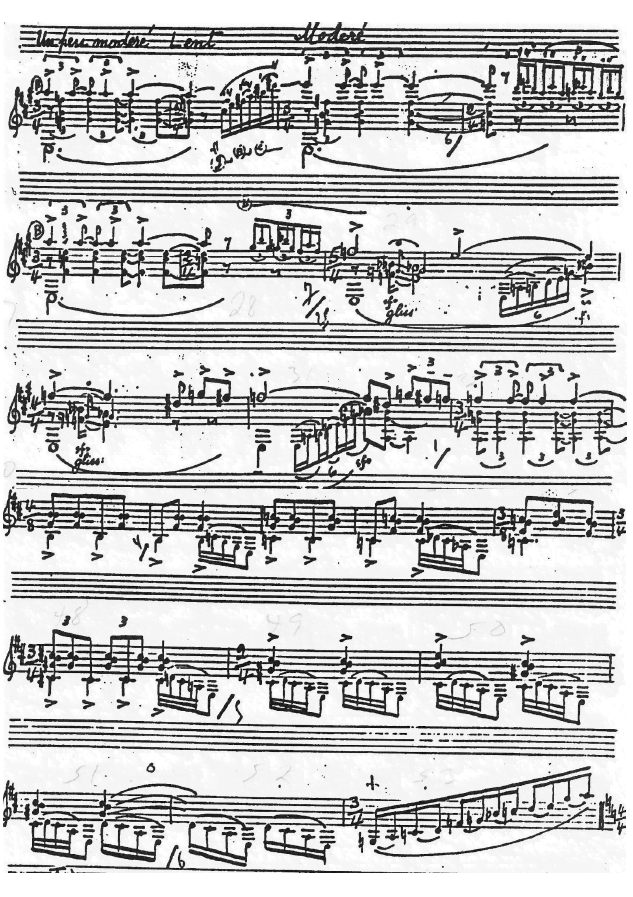


The two scores of this étude bring up the extremely haphazard editing done by the publisher (or composer) for the 1990 edition. There are a total of 32 measures missing from the1990 Edition that appear in the 1928 Manuscript.
Measures 17-56 are shown from the 1928Manuscript in Example 10A while measures 18-22 from the 1990 Edition in Example 10B. The major change comes at measure 21 in the 1928 Manuscript; however, for context, prior measures are included.
The reason to suspect haphazard editing is the glissando that is in both scores. The progression up the neck would make logical sense to end at a high E. It is very strange to have, as in the 1990 Edition, a tempo change and buildup for an intense moment only to end up at the bottom of the fret board.
It is mysterious why Villa-Lobos would have been so hasty in his editing. Possibilities include page limits to discontent over the different character of this haunting middle section. This middle section that appears in the 1928 Manuscript is possibly one of the most expressive moments of the entire cycle of studies. The two measures of anticipation that occur prior to the run in measure 20 also differ in both scores.
The 1990 Edition has half note chords in the high voice, while the 1928 Manuscript has quarter notes. The quarter notes allow for less decay and more buildup that releases in the middle, slow section.
However,it would appear that Villa-Lobos does not see a need for the buildup in the 1990 Edition because of the lack of such a pinnacle passage. It would therefore seem like a modification made in response to the cut of this middle section. Each version appears to serve its intended musical impression.

The slur section also features minor peculiarities. The melody in the bass has a haunting feeling that supposedly derives from roots in the Amazon jungle. Carlevaro discusses the melodies roots, saying, “Villa-Lobos told me this is true…of Study No. 10, both of which are influenced by the Amazon region. I once heard him refer to them as “Amazonic Studies”(Carlevaro 24).
There are two cases in the 1928 Manuscript where there is a low E added to the second half of the measure after a phrase ends. One case is in measure 57 (Example 10C) and another is in 64. Both versions have an E added in measure 68 for the 1928 Manuscript and measure 35 in the 1990 Edition. As seen in Example 10D, however, there are no low E’s in measures 24 or 31 for the 1990 Edition.
The low E coming at the end of a phrase serves as an echo and evokes even more the ‘Amazonic’ melody that Carlevaro discusses. As a result of both scores having this E in a later passage, there is no apparent reason for the 1990 Edition to ignore these notes for any technical or musical reason.

On a guitarist’s perspective, the last two measures of the study (measures 105-106 in the1928 Manuscript and measures 72-73 in the 1990 Edition) can be perplexing for right-hand fingerings.
While the 1990 Edition provides almost no fingerings for all the studies, the 1928Manuscript displays Villa-Lobos’s knowledge of the guitar with written in suggestions for both left hand and right-hand fingerings. Example 10E shows one particular technique Villa-Loboswas fond of (and later appears frequently in Étude No. 11); this technique is an ascending and descending arpeggio that is supposed to sound without break.
In the 1990 Edition, there is no line extending from the circled ‘i’ which can create confusion. Many guitarists believe that the lack of fingerings in the 1990 Manuscript directs to use the same fingers as in the ascending arpeggio for the descending arpeggio. The 1928 Manuscript, however, provides exact instructions for dragging the index fingers across the first four strings and then plucking the last note with the thumb.
Étude No. 11
This is the only étude that contains many additional passages in both scores that do not exist in the other score. While the 1990 Edition contains a lot more repetitive elements that do not exist in the 1928 Manuscript, the 1928 Manuscript has some completely new and unrelated material from what is written in the 1990 Edition.
In the 1990 Edition, the major change occurs in measures 29-32. This material is an exact reproduction of the material that is in measures 25-28. Conversely, the 1928 Manuscript does not repeat this section.


The next difference occurs in measure 30 of the 1928 Manuscript, and is missing between measures 33 and 34 in the 1990 Edition. As in Example 11A, there are D#-B dyads that were seen previously in the 1928 Manuscript, while Example 11B goes right into an arpeggio. It is possible that Villa-Lobos wanted a variant on what was heard twice in its entirety previously.
However, after the third time with this passage, the motive seems to tire; meanwhile, the 1928Manuscript cuts a lot of the repetition and adds new, unique passages that will be discussed next.

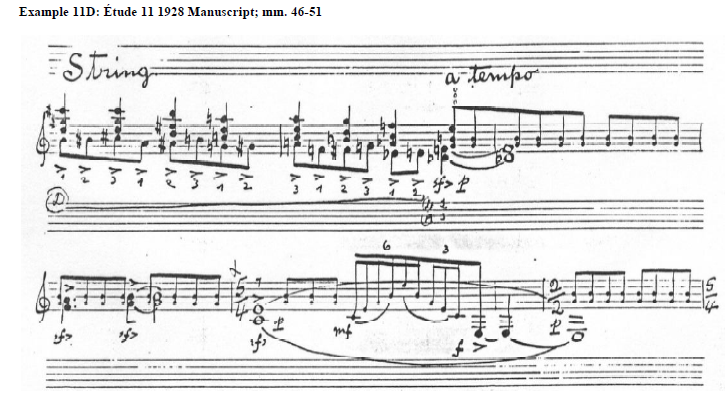
Examples 11C and 11D are two fascinating sections in Étude No. 11 that are omitted from the 1990 Edition. While these two excerpts are very much unlike the surround passages, they exhibit a certain Brazilian flair within a background of eighth notes.
In the first example, there is an impressive use of fast harmonics that create an effect not often heard of in the time of this composition. There is also a novel use of the left hand fourth finger as a bar. This could easily be the type of techniques that Villa-Lobos was exploring with when Segovia dismissed his knowledge of the guitar. It also could be passages that were deleted on Segovia’s request.
Example 11D changes the texture dramatically from unaccented eighth notes at a quick tempo to very fast and accented eighth notes. While the natural accents of the left-hand fingerings (suggested by Villa-Lobos) put these two measures in a triple-eighth time, the quarter notes have a two feel that formulates a hemiola familiar to Brazilian music.
While this section does not exhibit the technical struggle that the previous passage did, it is very jarring and could have been omitted for being so unlike the overall nature of the piece. This material appears between measures 39 and 40 in the comparable area in the 1990 Edition.

Étude No. 11 has the most dynamics of all other études in the 1990 Edition. While there are noticeable omissions in the 1990 Edition, in some passages, there is actually more detail than in the 1928 Manuscript. One such example is measures 56-57 in the 1928 Manuscript, and measures 50-51 in the 1990 Edition.
This section (both Examples 11E and 11F) is much more descriptive in the 1990 with added crescendos that create a phrase. While the piano in the end of the 1928 Manuscript is switched to a Mezzo-forte in the 1990 Edition, the 1928 Manuscript makes it unclear if Villa-Lobos intended for a swell in dynamics or a gradual tapering off. The 1990 Edition answers this question and is unusual for having more detail than the 1928 Manuscript.
Étude No. 12
There is only one difference in notes between the two scores in this étude. In measures61-62, for the 1990 Edition, there is a repeat of the material of measures 59-60. These two measures are not repeated in the 1928 Manuscript.


The main difference in this étude between the two scores, however, is the dynamical changes. Villa-Lobos takes time in the 1928 Manuscript to meticulously write many dynamical markings, including the crescendos and decrescendos (as in Example 12A). These mini-phrases follow the natural contour of the line, but the dynamics are almost completely missing from the1990 Edition (as seen in Example 12B). Throughout the study, these glissandos are not accompanied by any dynamic marking for the 1990 Edition while the 1928 Manuscript has many dynamics in these sections.
- Yates, Stanley. “Villa-Lobos’ Guitar Music: Alternative Sources and Implications forPerformance.” Soundboard Journal of the Guitar Foundation of America, XXIV.1 (1997):7-20.
